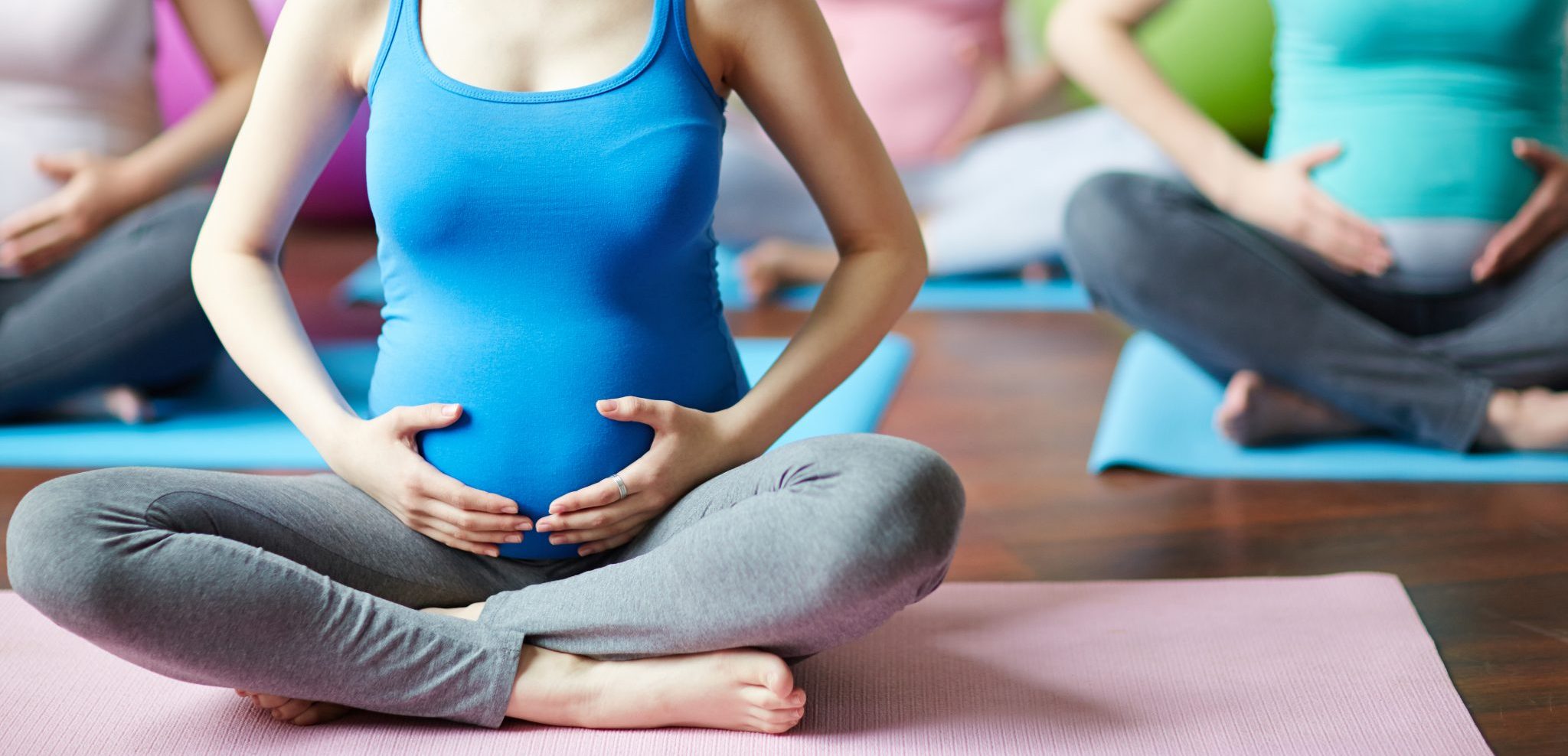Pregnancy is an experience that is both beautiful and challenging. Your whole body changes to create the perfect little home in your womb. For nine months, your body adjusts to its new form and needs extra support in certain areas to help you feel good.
Everyone can start practicing yoga at any level, so don’t worry if you have never practiced yoga before. You can start with a very slow and calming practice needed in the first trimester and grow into a confident yogi as time goes on. Yoga is extremely beneficial during pregnancy as long as you know what to do and what not to do.
It is important that you go to a professional yogi as this type of practice is delicate and you want to make sure that you are doing everything right. Choosing the right poses at the right phase of the pregnancy is imperative. And once you know what to do and when, you will feel the benefits including muscle strengthening, reduction in anxiety and pain relief.
Benefits Of Prenatal Yoga During Pregnancy
The benefits of prenatal yoga during and after pregnancy are both physical and mental. Both the body and mind need attention and yoga is the perfect place to do it. Most classes begin with breathing exercises followed by gentle stretches for the neck and the rest of the body.
Postures are tailored to the trimester of the pregnancy and fill in most of the class. You will usually find props to help complete the pose easily and without strain. The class finishes with relaxation and breathing. Prenatal yoga, restorative yoga and hatha yoga are the most recommended practices. Hot yoga should be avoided as it can cause hypothermia and create problems.
- Physical Benefits During Pregnancy. Prenatal yoga helps strengthen the muscles in core areas. It tones essential muscle groups which can minimise the strain and toll on a mother’s body. Yoga strengthens this area so that you can reduce the strain of carrying a few kilos extra. The lower back needs a lot of support and attention for a growing belly.
- Physical Benefits After Pregnancy. Loosening of the pelvic muscles also helps with child labor. Focusing on yoga poses that increase flexibility of the pelvis will contribute to the ease of the delivery and help your body go back to normal afterwards.
- Mental Benefits Of Yoga. Having a baby is one of the most life-changing experiences you can go through. Mentally, you are faced with worry, fear, excitement, happiness and the unknown. Emotions are a roller coaster and your mind is not the only one in control.
Your body changes and shifts your hormones into turbo mode. Yoga can help relax and quieten the mind so that you can react mindfully once the roller coaster starts to take over. When no one else is going through this massive adventure of pregnancy, you can feel very alone. Joining a yoga class is the perfect time to connect with other soon-to-be mamas. Sharing the experience with others reduces anxiety and helps calm the body and the muscles. - Practicing prenatal yoga also prepares you mentally for labor and delivery. By practicing deep breathing, your body can relax and stay loose during labor instead of freezing up as so many women do due to anxiety and stress of the experience.
- Last but not least, yoga gives you time for yourself. Once the pregnancy phase is finished, you will be totally dedicated to the newest member of your family. It is easy for new moms to forget about their own needs. Prenatal yoga practice is the perfect place to dedicate time to you. You can reflect on yourself and mentally prepare for the coming months.
You should always consult your doctor before starting a yoga practice, however most are pro-yoga as long as it is done with care. A study by the Yoga Journal – Susan Enfeld’s Why More Western Doctors are Now Prescribing Yoga found that:
“The healthcare world’s increased acceptance of yoga therapy is partly due to a significant body of clinical research. This research documents yoga’s proven benefits for a range of health conditions, including back pain, anxiety, depression, and insomnia.”
Susan Enfeld
Yoga and Pregnancy: Every Trimester Recommendations
Each phase of the pregnancy has a different effect on the body and requires a different yoga practice. The first trimester needs a gentle practice. The fetus is still very small and fragile and there is still a risk of miscarriage. In the second and third trimesters, there is more focus on preparing the mind and increasing muscle strength of the body.
Once again, make sure you practice with a professional. The last thing you need is to pull a muscle in the wrong place or create strain on you and the baby. Plus, working with someone else allows you to connect and know that you are not alone.
And remember to trust your instincts. A yogi can make sure that you are doing poses that are good for pregnancy, but nobody knows your body better than you do. If you are in doubt about a pose, then don’t do it and move to the next one.
Yoga For Pregnancy: First Trimester ( 1-13 Weeks)
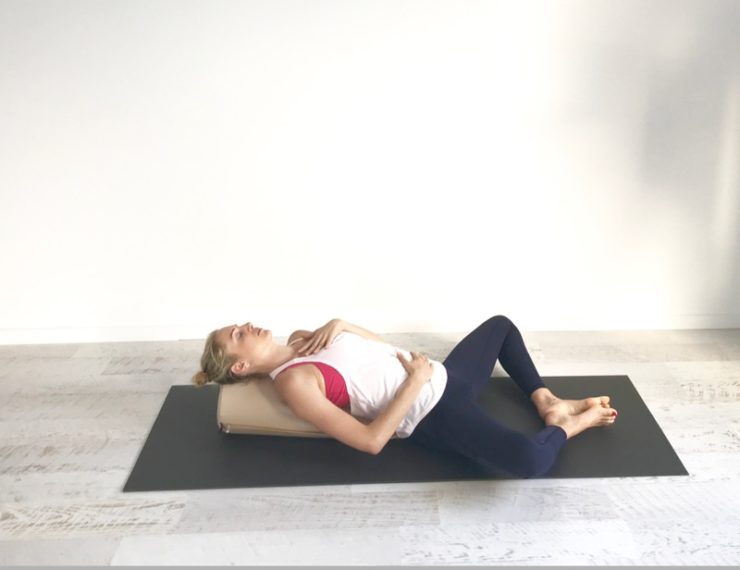
Some people wonder, can we do yoga in the first trimester of pregnancy? The answer is yes. You can even do yoga in the first month of pregnancy. But the type of yoga and the poses that you do are important to differentiate.
Your body may not be changing on the outside, but internally there is a lot going on. Hormones are changing and have the biggest effect on your body. No pregnancy can happen without an increase in estrogen – by 1000. This hormone facilitates growth in the uterus, maintains the lining, increases blood circulation and ignites other necessary hormones.
Progesterone increases by 10 times. This hormone ensures that everything in your body is working properly. It keeps placenta going and keeps the uterine lining healthy and thick. Alongside another hormone called relaxin, progesterone helps soften the cartilage. This creates aches in your hips and pelvic bones.
Everyone reacts differently during pregnancy. You may be someone who feels a lot of morning sickness. If you feel nauseous, this is your body telling you to relax a bit. The best you can do is to choose a yoga practice that is slow and focuses on breathing and mediation with some gentle stretches. Make sure you tell your yogi at which phase of the trimester you are in and let him/her know if you are feeling tired or unwell.
In the first trimester, less movement is more in yoga. Start your practice with breathing exercises and get your body relaxed for the first movements. Gentle neck and shoulder rolls such as Kantha and Skandha Sanchalana are a great start to any practice. Other poses you can do are the Bidalasana (Cat Pose) and the Viparita Karani (Legs Up To The Wall Pose) are quite energetic, but remember to have your feet resting on the wall to remove pressure from the stomach.
Some belly poses such as Cobra Pose are ok as long as you do not put pressure on the stomach. Stomach twists should be avoided and focus should be put more on the back. Also, avoid deep backbends as well as jumping movements. Inversions are not great as the redirect blood flow away from the uterus. Series of sun salutations can also take a lot of energy. Instead, opt for more slow-moving poses that help relax rather than exert.
Remember, you are pregnant and not injured. Make sure you recognise that although you cannot do all poses, you are still strong and can focus your energy on your mind and poses that steer away from your uterus during this fragile stage.
Yoga During Pregnancy: Second Trimester (14 To 28 Weeks)
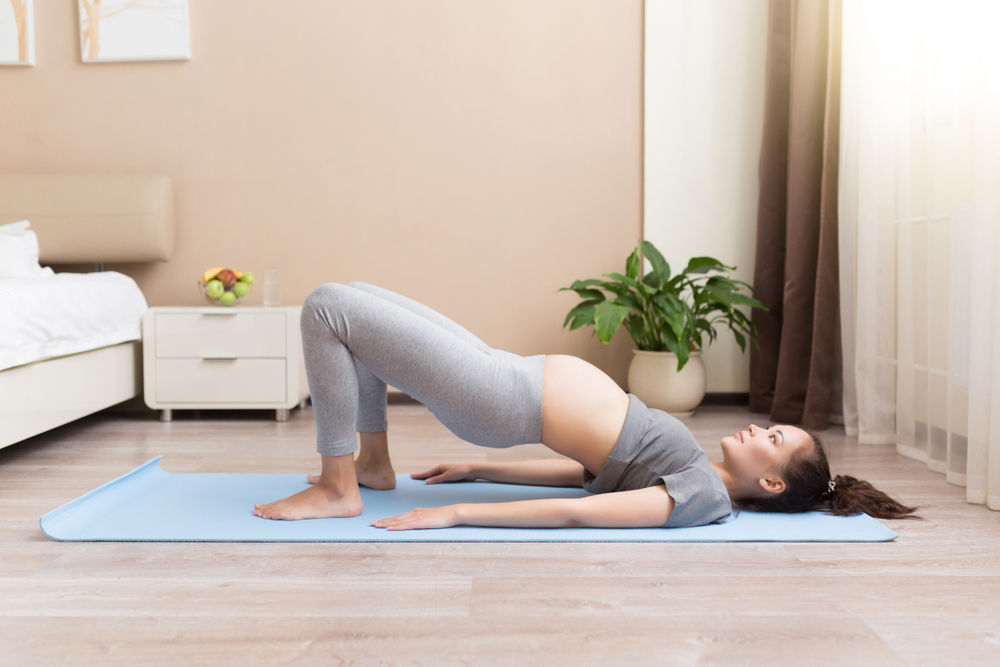
This is the perfect time to really get into your yoga practice. Your body is getting used to its new role, morning sickness has eased, your belly isn’t so big that it is causing you strain and both your womb and the baby are strong enough to handle light bends and stretches.
At this stage of the pregnancy, your body is beginning to feel the tension. Practicing yoga helps to increase progesterone levels to help relax muscles, aid circulation and improve digestion.
Keep in mind that you want to prevent your heart rate from doubling and avoid strenuous poses. The more difficult the pose, the more oxygen that is needed and this oxygen should actually be going to the baby.
Avoid going flat on your back, as this position makes the baby push in the wrong areas. When on your back the baby will rest on your vena cava and restrict blood flow to your heart. It is best to always support your back with a prop and bring your back to about 45 degrees.
4th Month Of Pregnancy
4 month pregnancy yoga is done at a time when the belly is beginning to show. Your belly is stretching and your breasts are fuller as they prepare for milking. The ligaments around the belly are stretched and the pelvis begins to loosen as it adjusts to hold the new weight of the baby.
Due to the pregnancy, the blood flow is low and causes dizziness, headaches and sometimes swelling in the hands and feet. In addition, some women feel cramping in the legs and suffer from varicose veins. That is why the second trimester of prenatal yoga focuses on reducing the discomfort.
5th Month Of Pregnancy
Yoga poses during the 5th month of pregnancy are similar to the 4th. The main difference is that you are bigger and have more discomfort. This is a good time to work on your core. Try poses that enhance spine alignment such as the Tadasana (mountain pose) and Urdhva Hastana (upward hand pose).
6th Month Of Pregnancy
Yoga during the 6th month of pregnancy can include a variety of standing asanas. Standing poses help strengthen the legs and circulate the blood to your feet to prevent swelling.
Try the Vrksasana (Tree Pose), Anjanesyasana (Cresent Low Lunge Pose), Ashta Chandrasan (Crescent High Lunge Pose), Utthita Trikonasana (Triangle Pose) and Virabhadrasana I & Virabhadrasana II (Warrior Pose I & II) for gentle stretching and breathing that you can control. If at any time you feel that the poses or too much, stop and rest. You can also use a table or chair to lean on for extra support and care.
Avoid contradictive poses such as belly and leg poses which can overstretch areas that are already being pulled to the max. It is also best to keep breathing exercises easy – without holding the breath in. The lack of oxygen can cause damage to the baby.
During the second trimester, most mothers can feel the baby moving in their belly. Yoga is a perfect time for mother and child to connect. Enjoy the resting time you have at the end of your yoga practice and remember that rest in general is great for both of you.
Pregnancy Yoga Poses: Third Trimester (29 To 40 Weeks)
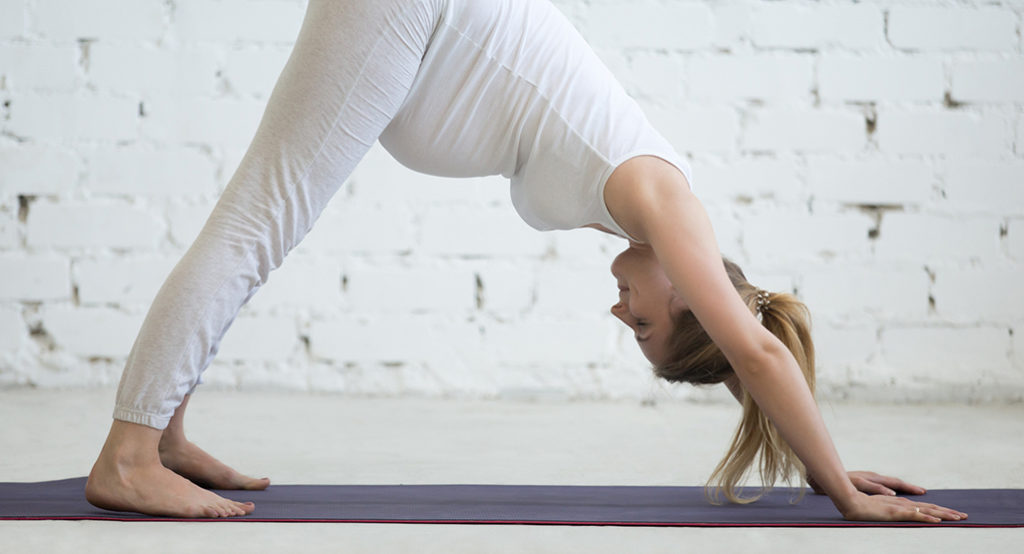
7th Month Of Pregnancy
Yoga during the 7th month of pregnancy focuses on relieving pain and strengthening the mind before delivery. This is the most strenuous time of pregnancy.
At this stage you feel every twist and move the baby makes. He or she has literally taken over your body and you now have the belly to show it. You’ve already done 7 months and you know that at the end of the road, you have a delivery to do.
Yoga in the third trimester aims to create space in your body that is now being compressed all over. You need to do poses that promote opening because the opposite, contracting, is already happening due to the baby in the womb.
Breathing exercises to help open the mind and think beyond the labor are also important. You need to mentally prepare for the next three months, the delivery and motherhood.
Jane Austin from San Francisco’s Prenatal Tree says:
In the third trimester, because space is so compromised in a mama’s body, the work of yoga is to make space in her body for her baby. So doing poses that create a sense of openness, rather than of contraction, become the focus because she is preparing for her body to completely open.
Jane Austin
At this stage you are 10 or 15 kilos heavier and perhaps feeling bigger. You are uncomfortable due to the extra weight, you can feel heartburn and the excessive need to pee. You’ll also find yourself looking for your breath and feeling the aches in your abdominal and lower back.
Not only that, the weight of the baby and the shape of your body can make it difficult to sleep. Your hormones, including progesterone and relaxin are working to make you loose and flexible for labor making you unstable and dizzy. These are difficult times! But prenatal yoga practice can definitely help you through it!!
8th Month Of Pregnancy
8 month pregnancy yoga focuses on breathing and hip opening poses.
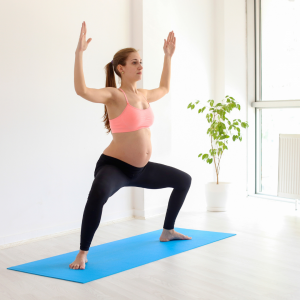
Utkata Konasana or Goddess Pose is an empowering pose and perfect to do during the third trimester. This pose lets you remember how strong you are while opening the hips at the same time. The pose is also very similar to the position you will be in during labour. It helps reduce tightness in the groin area and along with your legs, the natural force of gravity supports the belly as you stand and breathe.
Step-by-Step Instructions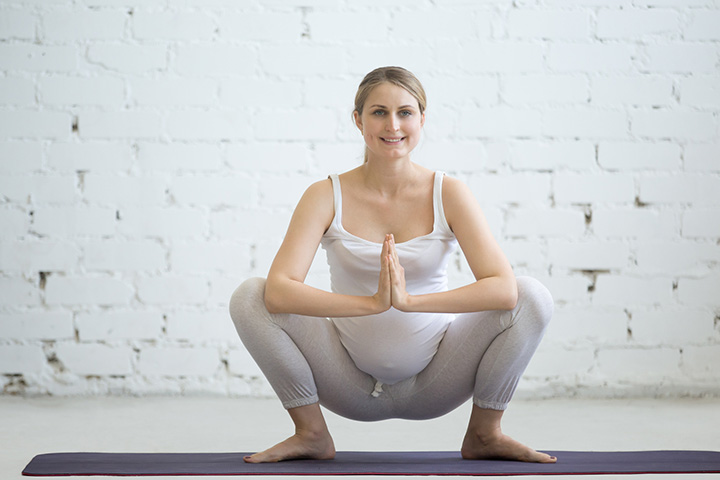
Squatting or Garland Pose is a similar pose and helps you dig deeper into the lower back ache. It works on the pelvic floor which you can practice tightening and loosening with every breath. This is also a great time to see if this is a delivery position that suits you. Please note that if your baby is in a breaching position, the squat pose should not be done anymore.
Step-by-Step Instructions9th Month Of Pregnancy
Yoga during the 9th and last month of pregnancy prepares you for the finish line. You are almost there! These poses are all about easing and releasing the strain from joints that suffer the most.

Child Pose
Balasana (Child Pose) is always a go to pose for everybody in every condition. Just remember to bring in a prop such as a large pillow so that your top half can rest on it and your belly rests on the ground. You don’t want to put too much pressure on the belly. The pillow helps you reach into the pose and also takes the pressure away from the baby.
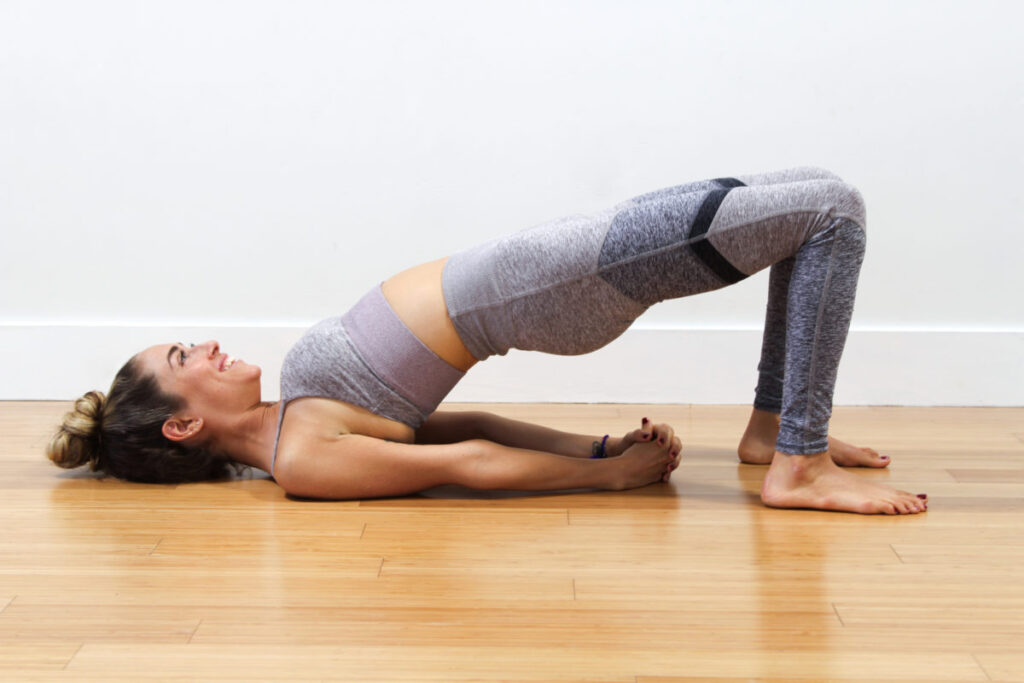
Bridge Pose
Setu Bandha Sarvangasana (Bridge Pose), temporarily relieves the pelvic bone. Both your pelvis and lower back have been working hard the last few months, so the more help you can give them, the better. If you need extra support, you can always add a block or a pillow just beneath the hips.
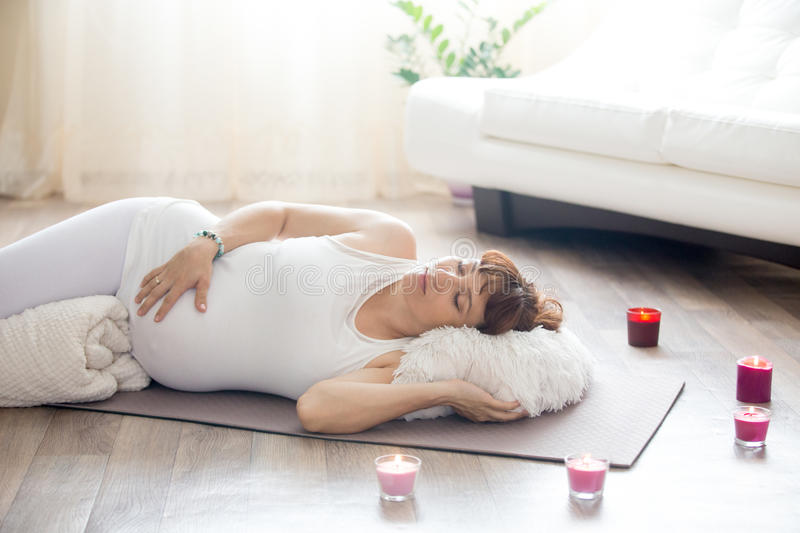
Corpse Pose On Your Side
Savasana I (Corpse Pose On Your Side) is another well-deserved resting pose. It is also a great pose during labor and contractions. Keep one leg up higher than the other by adding a pillow underneath. While in the pose, you can always ask your trainer or your partner to give you a nice massage and wrap up the practice.
So now that you know more about prenatal yoga, all you need to do is find the perfect studio and yogi. It is important to talk to your doctor, to your yogi, and make sure that you and your baby are safe. Once you feel comfortable and secure, you will be so happy that you have yoga practice to help you physically and mentally prepare for a magical nine-month journey.
